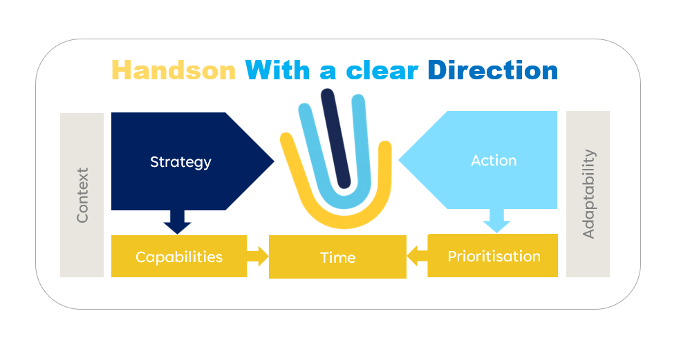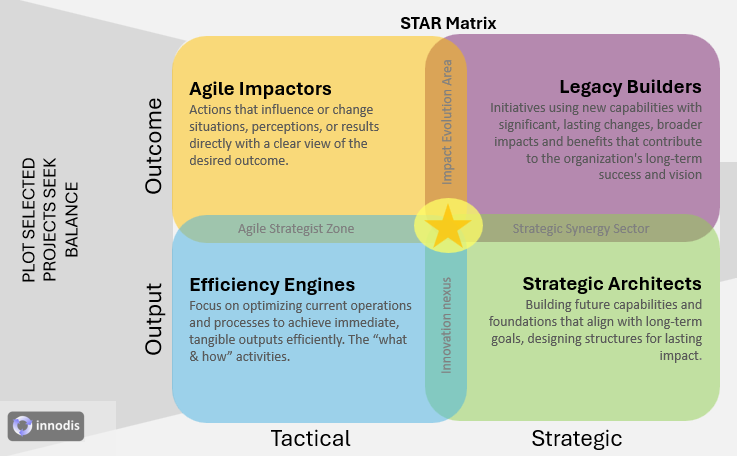A Comprehensive Guide to
Strategic and Tactical Excellence
As part of an assignment a request came how we could in a simple way bring strategy and actions together. This was the birth of the Star Matrix, a combination of well known terms in business

In the fast-paced world of business and organizational strategy, finding the right balance between immediate actions and long-term goals is crucial. The Strategic Tactical Actions & Results (STAR) Matrix offers a framework for navigating this complex landscape, blending tactical and strategic approaches with a focus on both outputs and outcomes. This blogpost a framework called the STAR Matrix, provides insights into its axes, quadrants, and overlapping zones, complete with definitions, rationales, and some examples.
The STAR Matrix
Defining the Axes
X-Axis: Tactical to Strategic
- The horizontal axis of the STAR Matrix moves from tactical on the left to strategic on the right. Tactical actions are immediate, short-term, and focused on efficiency and execution (more what & how), while Strategic actions are long-term, vision-oriented, and aimed at achieving overarching goals.
Y-Axis: Output to Outcome
- The vertical axis transitions from output at the bottom to outcome at the top. Output refers to the tangible products or results of actions, emphasizing quantity and quality of work completed. Outcome, conversely, focuses on the broader impact or change brought about by utilizing outputs, such as increased customer satisfaction or market share.
Exploring the Quadrants
Quadrant I: Efficiency Engines (Tactical and Output)
- Rationale: Focus on optimizing current operations to achieve specific, tangible outputs efficiently.
- Description: This quadrant focuses on short-term, immediate tasks and actions that are output-driven. The emphasis is on achieving specific, tangible products or results within a short timeframe.
- Characteristics: Activities are often routine or operational, such as daily tasks, minor improvements, or quick fixes. The goal is efficiency and productivity in current processes, with a focus on the "what" and "how" of tasks.
- Examples: Completing daily reports, manufacturing a set number of units, providing customer support.
Quadrant II: Strategic Architect (Strategic and Output)
- Rationale: Align outputs with long-term strategic goals, planning and building future capabilities.
- Description: This quadrant still focuses on outputs but with a long-term perspective. The strategy comes into play by aligning these outputs with broader organizational goals, though the focus remains on tangible products or results.
- Characteristics: Planning and execution are guided by the organization's strategic objectives, but the emphasis remains on measurable outputs that contribute to these goals. Activities might involve developing new products, entering new markets, or significant process improvements.
- Examples: Launching a new product line that aligns with the company's growth strategy, expanding operations to new geographical markets.
Quadrant III: Agile Impactor (Tactical and Outcome)
- Rationale: Achieve specific, impactful outcomes through flexible and responsive actions.
- Description: This quadrant shifts the focus towards the short-term achievement of specific (measurable) outcomes or impacts. The actions are still tactical but aim to influence or change situations, perceptions, or results directly.
- Characteristics: The emphasis is on immediate or short-term effects, improvements, or changes in behavior, status, or condition. Activities are more adaptive and may address immediate challenges or opportunities with a clear view of the desired outcome.
- Examples: Implementing a customer feedback system to improve service quality, a short-term marketing campaignwith positive ROI to increase brand awareness.
Quadrant IV: Visionary Horizon (Strategic and Outcome)
- Rationale: Focus on achieving significant, long-term outcomes that contribute to the organization's overarching vision.
- Description: This quadrant represents a focus on achieving long-term outcomes that are aligned with the organization's strategic vision. The emphasis is on broader impacts, changes, or benefits that contribute to the organization's long-term success.
- Characteristics: Activities and initiatives are designed to achieve significant, lasting changes. Planning is holistic and future-oriented, considering the wider implications and sustainability of outcomes. This approach often involves innovation, transformation, and long-term investments.
- Examples: Developing a sustainable business model, long-term brand positioning, strategic partnerships for future growth, Cultivating a sustainable business model that balances profitability with environmental responsibility.
Understanding the Overlapping Zones
Very often action or projects are in the overlapping zones and they're even preferred to a certain extend (the scoping can quickly introduce complexity. Personally my view is as always : kill complexity).
The Strategic Agility Nexus: The Heart of the Matrix
At the core of the STAR Matrix is the Strategic Agility Nexus, a gold or yellow-colored zone symbolizing the premium intersection where tactical flexibility meets strategic foresight. This zone emphasizes the capacity for immediate adaptation while keeping long-term visions in sight, embodying the ultimate goal of strategic planning and execution.
- Definition: A blend of tactical flexibility and strategic planning aimed at producing immediate outputs and long-term outcomes.
- Example: A cross-functional team that iterates on product features based on real-time user data while aligning with the strategic goal of market leadership.
Benefits of the Quadrant Split:
- Balanced focus: The matrix encourages organizations to maintain a balanced focus between immediate, tangible achievements and long-term strategic goals. This balance is crucial for sustaining growth and adapting to market changes.
- Strategic alignment: By categorizing actions across the quadrants, organizations can ensure that their day-to-day operations (tactical outputs) and short-term impact initiatives (tactical outcomes) are aligned with their strategic vision, whether it's through strategic outputs or outcomes.
- Resource optimization: The matrix can help in effectively allocating resources. Tactical actions, focused on outputs, might require different resources compared to strategic outcomes that may need more long-term investments. This clarity can lead to more efficient resource use.
- Innovation and agility: The split highlights the importance of agility and innovation (captured in the overlapping zones, especially the Strategic Agility Nexus). It prompts organizations to remain flexible and responsive to immediate challenges while still pursuing long-term objectives.
- Performance measurement: Each quadrant comes with its set of metrics for success. The matrix helps in setting clear KPIs for measuring both short-term achievements and long-term progress, aiding in continuous improvement.
Challenges of Implementing the Quadrant Split:
- Maintaining balance: While the matrix promotes a balanced approach, organizations may find it challenging to equally distribute attention and resources across the quadrants, potentially overemphasizing one area at the expense of others.
- Integration of efforts: Ensuring that initiatives across quadrants are not operating in silos but are integrated and mutually reinforcing can be complex. The strategic link between immediate outputs and long-term outcomes needs clear communication and collaboration.
- Adaptability to change: The external environment is dynamic, and sticking too rigidly to the quadrant framework may hinder adaptability. Organizations must remain fluid in their strategies, possibly moving actions between quadrants as circumstances evolve.
- Resource constraints: Especially for smaller organizations, the ambition to engage across all quadrants robustly may be hampered by limited resources, necessitating tough choices about where to focus efforts.
- Cultural alignment: Embedding a mindset that values both tactical and strategic, output and outcome-focused activities equally requires a cultural shift within many organizations. Achieving this alignment is often easier said than done.
The STAR Matrix : A communication vehicle
One significant challenge organizations face in strategic alignment is the complexity of communicating about strategy effectively. In this context, simplicity becomes paramount. The STAR Matrix offers an elegant solution by providing a clear and intuitive framework that encapsulates the essence of strategic planning and execution. By categorizing initiatives across tactical and strategic, output and outcome dimensions, the matrix simplifies the complex landscape of organizational actions. It enables stakeholders at all levels to see at a glance how daily activities align with broader strategic goals. This visual and straightforward approach facilitates better understanding, engagement, and communication across the organization.
Summary
The STAR Matrix serves as a simple framework for organizations seeking to navigate the complexities of modern strategy and operations. By understanding its axes, quadrants, and overlapping zones, leaders can better align their actions with both immediate needs and long-term goals, fostering an environment of strategic agility and sustained success. Whether focusing on the Efficiency Engine or aspiring to the Visionary Horizon, the STAR Matrix can offer a roadmap to strategic and tactical excellence.
As always with frameworks the biggest benefit of a framework is it's simplicity. This is an excellent vehicle in communication actions that leaders need to do continiously.
Do not hesitate to read other blogposts on prioritisaton, leadership, simplicity,....
